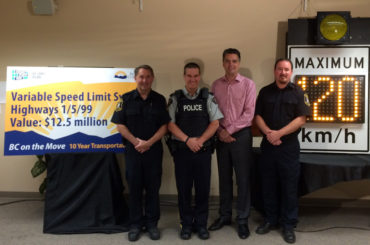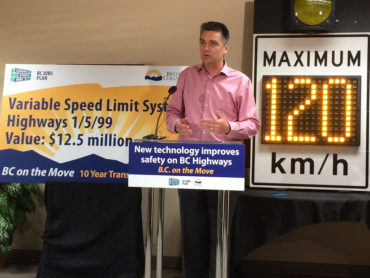
Enforceable variable speed limit signs aimed at reducing weather-related crashes “go live” in British Columbia
June 3, 2016 by Canadian Underwriter
Print this page Share
Variable speed signs are now active in three locations throughout the province of British Columbia as part of a project to help reduce the frequency and severity of weather-related crashes.

The variable speed limit signs are now activated in the Coquihalla, Sea to Sky and the Trans-Canada Highway near Revelstoke. Credit: B.C. Ministry of Transportation and Infrastructure.
B.C. Minister of Transportation and Infrastructure Todd Stone said on Thursday that the variable speed limit signs are now activated in the Coquihalla, Sea to Sky and the Trans-Canada Highway near Revelstoke. “It is important drivers understand that along these corridors, these signs aren’t ‘speed readers’, they are the law,” Stone said in a statement. “These electronic signs will adjust the speed limit according to conditions and will require drivers to slow down and reduce their speed in bad weather.”
Whether it is extreme cold, freezing rain or heavy snowfall, an extensive system of traffic, pavement and visibility sensors are calibrated to detect the conditions and provide a recommended speed to operations staff located in the Regional Traffic Management Centre in Coquitlam, the Ministry of Transportation and Infrastructure explained in the statement. The recommended speed will be used to update the speed shown on digital signs, to help drivers know a safe driving speed during adverse weather conditions.

The variable speed limit program is also supported by recent changes in the B.C. Motor Vehicle Act regulations that allow police to enforce these posted speeds. Credit: B.C. Ministry of Transportation and Infrastructure.
This safety initiative targets critical sections of Highways 1, 5 and 99. Crews have now installed 18 variable speed signs along Highway 1 from Perry River to Revelstoke, 13 along the Coquihalla from Portia Interchange to the former Toll Plaza and 16 along the Sea to Sky from Squamish to Function Junction.
Related: Sections of roadways in British Columbia to get variable speed signs
The variable speed limit program is also supported by recent changes in the B.C. Motor Vehicle Act regulations that allow police to enforce these posted speeds, the transportation and infrastructure ministry reported. Drivers are encouraged to be aware when they enter a variable speed limit zone that posted limits are the maximum speeds allowed. Drivers failing to obey the posted variable speed limit may receive a traffic violation ticket carrying a fine of between $138 and $483 as well as three penalty points. Offences and infractions that include penalty points can lead to a driving prohibition and vehicle impoundment.
The digital signs will be “very visible” to drivers, and the speed limit will be adjusted to reflect driving conditions, the statement explained. Overhead message signs at the entrance of each corridor will inform drivers to be aware of changing weather conditions and flashing amber lights will alert drivers to adjusted speeds that are not the posted limits along these corridors.

Overhead message signs at the entrance of each corridor will inform drivers to be aware of changing weather conditions and flashing amber lights will alert drivers to adjusted speeds that are not the posted limits along these corridors. Credit: B.C. Ministry of Transportation and Infrastructure.
“Many highways in B.C. pass through different climate zones, and the Sea to Sky Highway is no exception,” said West Vancouver-Sea to Sky MLA Jordan Sturdy in the statement. “Motorists that drive Highway 99 are familiar with rapidly changing weather conditions, where it is not uncommon to experience sunny and dry conditions, as well as rain, sleet or a full-blown snowstorm somewhere along the way. These signs alert drivers to the need to adjust their speed to current conditions.”
Chief Constable Neil Dubord, chair of the B.C. Association of Chiefs of Police Traffic Safety Committee said that speeding is the leading cause of fatal car crashes in British Columbia. “Seven out of ten speed-related crashes are related to driving too fast for the road conditions,” he noted.
The ministry has invested $12.5 million to install and run the pilot systems that were largely made and manufactured in B.C. The pilot program is part of the ministry’s $25-million per-year Road Safety Improvement Program.
Have your say: